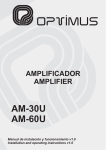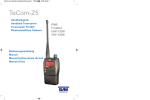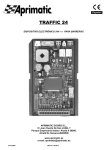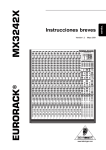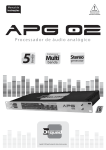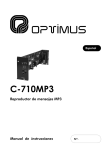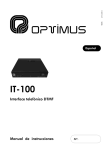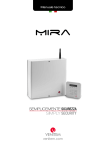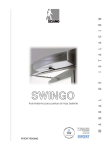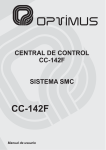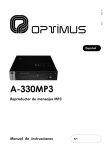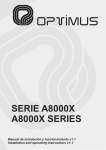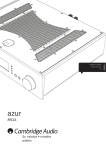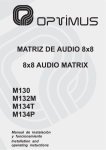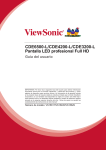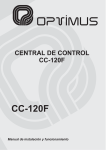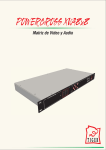Download PM-CH7 - Optimus
Transcript
PREAMPLIFICADOR PREAMPLIFIER PM-CH7 Manual de instalación y funcionamiento v1.0 Installation and operating instructions v1.0 PM-CH7 Preamplificador INSTRUCCIONES DE SEGURIDAD: IMPORTANTE: Los códigos de color de los cables de red son los siguientes: Verde y amarillo Tierra (E) Azul Neutro (N) Marrón Positivo (L) Si los colores de los cables de red de este aparato no se corresponden con las marcas de sus terminales de conexión, debe procederse como sigue: Conectar el cable de color verde y amarillo al terminal marcado con la letra E o con el símbolo de tierra. Conectar el cable de color azul al terminal negro o marcado con la letra N. Conectar el cable de color marrón al terminal rojo o marcado con la letra L. Si se usa un conector macho de 13 A (BS1363), o de cualquier otro tipo, debe colocarse un fusible de 5 A en el conector o en la caja de distribución. INSTALACIÓN GENERAL NO PASAR los cables de micrófono cerca de cables telefónicos, de datos o de línea de 100 V. NO PASAR los cables de línea de 100 V cerca telefónicos, de datos o de baja tensión. NO SOBREPASAR el 90% de la potencia de salida de los amplificadores cuando se utiliza la línea de 100 V para avisos. NO SOBREPASAR el 70% de la potencia de salida de los amplificadores cuando se utiliza la línea de 100 V para música ambiental a alto volumen. NO UTILIZAR altavoces exponenciales para música ambiental, excepto si éstos han sido especialmente diseñados para esta función. EVITAR empalmes en los cables de micrófono. Si es inevitable, utilizar exclusivamente conectores blindados de buena calidad, como los XLR. Utilizar SIEMPRE para distancias largas, micrófonos balanceados de baja impedancia o aislados de la masa conectados a entradas balanceadas. Utilizar SIEMPRE un cable doble aislante de calidad equivalente a los de la red de baja tensión para las conexiones de los altavoces. ASEGURARSE de que todos los altavoces estén en fase. ASEGURARSE de que no existe ningún cortocircuito en la línea de altavoces antes de conectarla al amplificador. PM-CH7 Versión 1.0 Página 1 de 12 PM-CH7 Preamplificador ÍNDICE 1. DESCRIPCIÓN ........................................................................................................ 3 2. PANEL FRONTAL ................................................................................................... 4 3. PANEL POSTERIOR ............................................................................................... 4 4. CONEXIONES Y FUNCIONAMIENTO .................................................................... 5 5. 4.1. ENTRADA TEL / EMER (1) .......................................................................................... 5 4.2. ENTRADA CH1 (3) ....................................................................................................... 5 4.3. ENTRADAS CH2-CH6 (6 y 7) ...................................................................................... 5 4.4. ENTRADAS CH7 .......................................................................................................... 5 4.4.1. ENTRADA CD (9) ...............................................................................................................5 4.4.2. ENTRADAS AUX / TUNER (10 y 11).................................................................................5 4.5. SALIDA PRE OUT / ENTRADA POWER IN (12)......................................................... 5 4.6. SALIDA TAPE OUT (14) .............................................................................................. 6 4.7. SALIDA MASTER OUT (15 y 16) ................................................................................ 6 4.8. CONECTOR DIN MASTER / SLAVE (17).................................................................... 6 4.9. CONEXIÓN DE GND Y CHASIS (19) .......................................................................... 6 4.10. OVERRIDE (20)............................................................................................................ 6 4.11. CONEXIÓN DE ALIMENTACIÓN 24 VCC (21) ........................................................... 6 4.12. CONEXIÓN BATERIA 24 VCC (22) ............................................................................. 6 4.13. INTERRUPTOR POWER ON / OFF (1)........................................................................ 6 4.14. VUMETRO DE SALIDA (3) .......................................................................................... 6 CONFIGURACIÓN .................................................................................................. 7 5.1. PRIORIDAD.................................................................................................................. 7 5.2. DIP SWITCH DE CONFIGURACIÓN CH1-CH6 (5) ..................................................... 7 5.2.1. PARÁMETROS ESPECÍFICOS PARA EL CH1 ................................................................7 5.2.2. PARÁMETROS PARA CANALES CH1-CH6 ....................................................................7 5.3. FILTRO DE PALABRA ................................................................................................ 7 5.4. VOX .............................................................................................................................. 8 5.5. PUERTA DE RUIDO (VCA).......................................................................................... 8 6. DIAGRAMA DE BLOQUES..................................................................................... 9 7. SITUACION DE LOS JUMPERS EN EL PCB......................................................... 9 8. ESPECIFICACIONES TÉCNICAS......................................................................... 10 9. CERTIFICADO DE GARANTÍA............................................................................. 12 PM-CH7 Versión 1.0 Página 2 de 12 PM-CH7 Preamplificador 1. DESCRIPCIÓN Preamplificador mezclador de 1 unidad de rack estándar de 19”. Dispone de 7 canales de entrada con ajustes de volumen y tono independientes. Canal 1-6 con sensibilidad Micro / Línea ajustable. Prioridad por VOX o contacto seleccionable para el canal 1. Gong seleccionable para el canal 1 con nivel ajustable. Filtro de palabra seleccionable para mejora de inteligibilidad de palabra. Canal 7 para selección entre 3 entradas para fuentes musicales, CD, AUX o TUNER. Entrada TEL/ EMER con prioridad por VOX para avisos de emergencia. Potenciómetro Master para ajustar el nivel de salida general de la unidad. Conectores RCA con salida de señal no balanceada para PRE OUT, TAPE OUT y MASTER OUT. Conector XLR con salida de señal balanceada para MASTER OUT. Conector MASTER / SLAVE para expandir el sistema a 2 unidades ampliando el número de canales de 7 a 14. PM-CH7 Versión 1.0 Página 3 de 12 PM-CH7 Preamplificador 2. PANEL FRONTAL (1) Interruptor de encendido ON/OFF (6) Controles de tono CH1-CH6 (2) LED de alimentación (7) Selector de fuente musical (3) VUMETRO de salida (8) LED indicador de fuente musical (4) Control de volumen MASTER (9) Control de Graves y agudos CH7 (5) Controles de nivel de entrada CH1-CH6 (10) Control de Nivel de entrada CH7 3. PANEL POSTERIOR (1) Entrada TEL/EMER (12) Salida PRE OUT (2) Control de nivel TEL/EMER (13) Entrada POWER IN (3) Entrada CH1 (14) Salida TAPE OUT (4) Control de nivel del Gong de entrada CH1 (15) Salida no balanceada MASTER OUT (5) Dipswitch CH1 y CH2 (16) Salida balanceada MASTER OUT (6) Entrada XLR del CH2 (17) Conector DIN MASTER / SLAVE (7) Entrada XLR del CH3-CH6 (18) Interruptor MASTER /SLAVE (8) Dipswitch del CH3-CH6 (19) Unión GND y chasis (9) Entrada de CD (20) Override (10) Entrada auxiliar (21) Entrada de alimentación 24 Vcc (11) Entrada Tuner (22) Entrada de alimentación para batería 24 Vcc PM-CH7 Versión 1.0 Página 4 de 12 PM-CH7 Preamplificador 4. CONEXIONES Y FUNCIONAMIENTO 4.1. ENTRADA TEL / EMER (1) Entrada balanceada con prioridad por VOX. Prioridad máxima respecto al resto de entradas. Control de volumen independiente ubicado en el panel posterior. El nivel de señal de esta entrada no se ve afectado por la regulación del control de volumen MASTER. Umbral de activación del VOX controlable mediante potenciómetro VR3 de la placa interna. 4.2. ENTRADA CH1 (3) Entrada balanceada con sensibilidad Micro / Línea seleccionable. Dispone de prioridad configurable por VOX o por contacto. Conexión mediante 3 terminales en la regleta de entrada de señal correspondientes a (GND / + / -) para la conexión del audio balanceado y dos terminales de contacto para activar la función de prioridad. Gong de preaviso configurable activado desde el contacto de prioridad. 4.3. ENTRADAS CH2-CH6 (6 y 7) Entradas balanceadas mediante conectores XLR, con sensibilidad Micro / Línea y alimentación phantom seleccionable. 4.4. ENTRADAS CH7 El canal 7 dispone de 3 entradas para fuente musical, con un control volumen, graves y agudos general. La entrada asignada al canal se selecciona desde el pulsador SELECTOR en el panel frontal. 4.4.1. ENTRADA CD (9) Entrada no balanceada de 500 mV mediante dos conectores RCA indicada para introducir una señal procedente de una fuente musical. 4.4.2. ENTRADAS AUX / TUNER (10 y 11) Entradas no balanceadas de 200 mV mediante dos conectores RCA indicadas para introducir una señal procedente de una fuente musical. 4.5. SALIDA PRE OUT / ENTRADA POWER IN (12) Entrada / Salida de sensibilidad 1 V utilizada para intercalar equipos externos (ecualizador, supresor de Efecto Larsen…). Salida PRE-OUT mediante conector RCA, señal preamplificada controlada por el master. Entrada POWER IN mediante conector RCA. PM-CH7 Versión 1.0 Página 5 de 12 PM-CH7 Preamplificador En caso de no usar esta funcionalidad, el puente de interconexión entre PRE-OUT y POWER IN debe estar colocado. 4.6. SALIDA TAPE OUT (14) Señal de salida para grabación no controlada por el Master. Conexión mediante conectores RCA a nivel de 350 mV. 4.7. SALIDA MASTER OUT (15 y 16) Salida general a nivel de 1 V. Está controlada por el volumen Master y dispone de doble conexión, balanceada mediante conector XLR (16) y no balaceada (15) mediante dos conectores RCA. 4.8. CONECTOR DIN MASTER / SLAVE (17) Conector de expansión para interconectar 2 unidades. Al interconectar 2 unidades se obtendrán 14 canales con 14 niveles de prioridad distintos, siendo las entradas de la unidad master más prioritarias que la unidad SLAVE. La máxima prioridad disponible para la unidad SLAVE es equivalente a la fuente musical de la unidad MASTER, motivo por el cual se recomienda que si se utilizan fuentes musicales, se conecten siempre a la unidad SLAVE. 4.9. CONEXIÓN DE GND Y CHASIS (19) Para evitar ruidos provocados por bucles de masa es muy importante que haya un solo punto de unión entre la masa de señal y el contacto de tierra de la red. Si la instalación de megafonía está compuesta por varios equipos, probablemente tendrán los chasis unidos, bien mediante el terminal de tierra de la conexión a la red, o bien porque estén montados en un armario rack. Si las masas están también unidas por los circuitos de señal, es aconsejable quitar el puente entre la masa y el chasis de todos los aparatos excepto uno. 4.10. OVERRIDE (20) Contacto libre de tensión que se cierra al activarse la prioridad de la entrada TEL / EMER. 4.11. CONEXIÓN DE ALIMENTACIÓN 24 VCC (21) Terminales de conexión de alimentación 24 Vcc. 4.12. CONEXIÓN BATERIA 24 VCC (22) Terminales de conexión para alimentación mediante batería de 24 Vcc. 4.13. INTERRUPTOR POWER ON / OFF (1) Pulse el interruptor para encender o apagar la unidad, el encendido de la unidad se indicará mediante el encendido del LED de alimentación. En un sistema de megafonía, el preamplificador siempre debe ser el primer equipo a encenderse y el último a apagarse. 4.14. VUMETRO DE SALIDA (3) Una barra de 5 LEDs indica el nivel de señal de salida del amplificador, si el LED rojo se enciende, disminuya el nivel de salida mediante los potenciómetros de volumen de las señales entrantes. PM-CH7 Versión 1.0 Página 6 de 12 PM-CH7 Preamplificador 5. CONFIGURACIÓN 5.1. PRIORIDAD La configuración de las prioridades del sistema viene definida por de la posición de los Jumper internos SW9, SW10 y SW11. El equipo dispone de tres niveles de prioridad diferentes; Block before, Block behind y Serial. Modo Serial: Las prioridades quedan definidas según el número de canal. Siendo CH1 el canal de prioridad máxima y CH7 el de prioridad mínima (CH1 > CH2 > CH3 > CH4 > CH5 > CH6 > CH7). Modo Block before: De los canales CH1, CH2, CH3, CH4, CH5 y CH6, el primero en activarse tendrá la máxima prioridad y bloqueará el resto de canales incluido el CH7 que no tiene prioridad. Modo Block behind: De los canales CH1, CH2, CH3, CH4, CH5 y CH6, el último en activarse tendrá máxima prioridad y bloqueará el resto de canales, incluido el CH7 que no tiene prioridad. 5.2. DIP SWITCH DE CONFIGURACIÓN CH1-CH6 (5) Mediante los dipswich del panel posterior se permite la modificación de una serie de parámetros. 5.2.1. PARÁMETROS ESPECÍFICOS PARA EL CH1 Chime / Off: en posición Chime el equipo reproducirá un gong de preaviso al activarse la prioridad del canal 1. Se puede regular el volumen del gong mediante el potenciómetro situado en la parte trasera del equipo (4). PTT / Off: En posición PTT, la señal de audio de la entrada 1 no se enviara a la salida si no se cierra el contacto de prioridad entre los terminales de la regleta. En posición Off no es necesario el contacto de la regleta para enviar el audio a la salida. En ambos caso al cerrar el contacto de prioridad se silenciaran el resto de canales. 5.2.2. PARÁMETROS PARA CANALES CH1-CH6 Line / Mic: Selección de la sensibilidad entre -60 dB (MIC) o 0 dB (LINE). Phantom / Off: Permite habilitar o deshabilitar la alimentación phantom. Este microinterruptor gobierna dos canales, por lo que se recomienda tener especial cuidado al activar esta función. La alimentación phantom debe deshabilitarse en el modo Line. 5.3. FILTRO DE PALABRA Los canales CH1-CH6 disponen de un filtro de palabra que puede ser habilitado o deshabilitado mediante jumpers (SW1, SW2, SW3, SW4, SW5, SW6) de la placa PCB. El filtro de palabra mejora la inteligibilidad de palabra mediante el recorte de las frecuencias más bajas. PM-CH7 Versión 1.0 Página 7 de 12 PM-CH7 5.4. Preamplificador VOX Los canales CH1-CH6 disponen de la función VOX que puede ser habilitada o deshabilitada mediante jumpers (JUMPER 1, JUMPER 2, JUMPER 3, JUMPER 4, JUMPER 5, JUMPER 6) de la placa PCB. 5.5. PUERTA DE RUIDO (VCA) El equipo dispone de una puerta de ruido a nivel general activable mediante el JUMPER SW7 y ajustable mediante el potenciómetro P19, ambos controles situados en la placa PCB. PM-CH7 Versión 1.0 Página 8 de 12 PM-CH7 Preamplificador 6. DIAGRAMA DE BLOQUES 7. SITUACION DE LOS JUMPERS EN EL PCB PM-CH7 Versión 1.0 Página 9 de 12 PM-CH7 Preamplificador 8. ESPECIFICACIONES TÉCNICAS CH1-CH6 Mic: 1 mV, balanceada con alimentación phantom CH1-CH6 Line: 200 mV, 47 kΩ balanceada CH7 CD: 500 mV, 47 kΩ, desbalanceada Entradas CH7 Tuner: 200 mV, 47 kΩ, desbalanceada CH7 Aux: 200 mV, 47 kΩ, desbalanceada TEL: 1 V, 600Ω, ajustable, balanceada Power In: 47 kΩ, 1 V, desbalanceada Master Out: 600 Ω, 1V, XLR balanceada, RCA desbalanceada Salidas Tape Out: 350 mV, 4.7 kΩ Pre Out: 600 Ω, 1 V CH1-CH6 Mic: 60 ~ 15.000 Hz ± 3 dB Respuesta en Frecuencia CH1-CH6 Line: 50 ~ 20.000Hz ± 3 dB CH7 CD / Tuner / AUX 50 ~ 20.000 Hz ± 3 dB TEL: 100 ~ 15.000 Hz ± 3 dB Distorsión armónica total < 0.5 % a 1 KHz CH1-CH6 Mic: 60 dB Relación señal/ruido CH1-CH6 Line: 75 dB CH7 CD /Tuner/AUX: 75 dB TEL: 75 dB CH1-CH6 Bass: ± 3 dB a 300 Hz Controles de Tono Treble: ± 3 dB a 10 KHz CH7 Bass: ± 10 dB a 100 Hz Treble: ± 10 dB a 10 kHz Mic > 25 dB Margen dinámico Line > 25 dB Tel > 20 dB CD > 25dB PM-CH7 Versión 1.0 Página 10 de 12 PM-CH7 Preamplificador AUX > 25 dB Tuner > 25 dB Filtro de palabra CH1-CH6: -3.5 dB a 315 Hz Alimentador 24 Vcc (Máx 10% de desviación) Batería 24 Vcc (Máx 10% de desviación) Alimentación Consumo Dimensiones (mm) 1A 438 x 222 x 44 peso 2.85 kg color Negro Unidades de Rack PM-CH7 Versión 1.0 1 Página 11 de 12 PM-CH7 Preamplificador 9. CERTIFICADO DE GARANTÍA 7. En el caso de ordenadores PC, la garantía no cubrirá la eliminación de virus informáticos, restauración de programas por este motivo o la reinstalación del disco provocada por el borrado del mismo. 1. La empresa OPTIMUS S.A. garantiza que sus productos se encuentran libres de defectos en materiales y de mano de obra en el momento de su entrega original al comprador. 8. Los derechos de garantía se anulan si el producto ha sido reparado o abierto por un personal no autorizado OPTIMUS S.A. o por el propio cliente. 2. La empresa OPTIMUS S.A. concede a sus productos, conforme a las condiciones aquí descritas, una garantía de dos (2) años a partir de la fecha de adquisición del producto por el comprador. Si, dentro de este plazo de garantía, se producen defectos que no sean debidos a razones mencionadas bajo el punto 2, la empresa OPTIMUS S.A. remplazará o reparará el aparato utilizando piezas de recambio equivalentes, nuevas o reconstruidas, según criterio propio. Si se aplican piezas de recambio que constituyen una mejora del aparato, la empresa OPTIMUS S.A. se reserva el derecho de cargar el coste adicional de estos componentes al cliente. 3. No se concederán prestaciones de garantía distintas a las citadas. 4. Para la utilización de los derechos de garantía será requisito indispensable presentar la factura de compra original o el certificado de garantía. 2. DISPOSICIONES DE GARANTÍA 1. Si el producto tuviera que ser modificado o adaptado para cumplir con los requisitos locales en cuanto a técnica o seguridad, si no se trata del país para el cual el producto fue concebido y fabricado originalmente, ello no se considera como defecto de material o de fabricación. Por lo demás, la garantía no comprende la realización de estas modificaciones o adaptaciones, independientemente de si éstas hayan sido ejecutadas debidamente o no. OPTIMUS S.A. tampoco asumirá costes en el marco de la garantía por este tipo de modificaciones. 2. La garantía no dará derecho a inspección o mantenimiento gratuito o reparación del aparato, particularmente si los defectos son debidos a uso inapropiado. Los derechos de garantía tampoco abarcan defectos en piezas de desgaste que sean debidos a un desgaste normal. Piezas de desgaste son, en particular, potenciómetros, interruptores/teclas, y piezas similares. 3. La garantía no abarca los defectos en el equipo causados por: ¾ ¾ ¾ ¾ ¾ ¾ ¾ ¾ Abuso o uso incorrecto del aparato para fines distintos a los previstos, en incumplimiento de las instrucciones de servicio y de mantenimiento especificadas en el Manual y/o Instrucciones Técnicas del equipo. Conexión o uso del producto de una manera que no corresponda a los requisitos técnicos o de seguridad del país en el cual se utiliza el aparato. Instalación en condiciones distintas a los indicados en el Manual y/o Instrucciones Técnicas. Deficiencia o interrupciones tensión eléctrica o defectos de instalación que impliquen uso en condiciones anormales. Daños ocasionados por otros equipos interconectados al producto. El uso o instalación de Software (programas), interfaces, partes o suministros no proporcionados y/o autorizados por OPTIMUS S.A. La no utilización de los embalajes originales para su transporte. Daños causados por fuerza mayor u otras causas no imputables a OPTIMUS S.A. 4. No están cubiertos por esta garantía los siguientes elementos: ¾ ¾ ¾ ¾ Todas las superficies de plástico y todas las piezas expuestas al exterior que hayan sido rayadas o dañadas debido al uso normal o anormal. Las roturas, golpes, daños por caídas o ralladuras causadas por traslados de cualquier naturaleza. Defectos de daños derivados de pruebas, uso, mantenimiento, instalación y ajustes inapropiados, o derivados de cualquier alteración o modificación de cualquier tipo no realizada por en Servicio Autorizado por OPTIMUS S.A. en cumplimiento de esta garantía. Los daños personales o a la propiedad que pudieran causar el uso indebido del equipo, incluyendo la falta de mantenimiento. 5. La garantía carecerá de validez cuando se observe: ¾ ¾ ¾ Enmiendas o tachaduras en los datos del certificado de garantía o factura de compra. Falta de factura original o falta de fecha en la misma. Falta de número de serie o lote en el equipo. 9. Si la empresa OPTIMUS S.A. estableciera al comprador del aparato que los daños presentados no dan derecho a la reclamación de la garantía, los costes de las prestaciones de revisión por parte de la empresa OPTIMUS S.A. correrán a cargo del cliente. 10. Los productos sin derechos de garantía sólo se repararán contra pago de los gastos por el cliente. En caso de ausencia de derechos de garantía, OPTIMUS S.A. informará al cliente al respecto. Si, en un plazo de 6 semanas a partir de esta comunicación, no recibimos ninguna orden de reparación escrita confirmando la aceptación de los gastos, OPTIMUS S.A. devolverá el aparato en cuestión al cliente. En este caso, los gastos de transporte y embalaje se facturarán por separado y se cobrarán contra reembolso. En caso de expedición de una orden de reparación, confirmando la asunción de los gastos, los gastos de transporte y de embalaje se facturarán adicionalmente, igualmente por separado. 11. En caso de necesidad de traslado al Centro de Servicio Autorizado, el transporte será realizado por el responsable de la garantía, y serán a su cargo los gastos de flete y seguro. 12. En caso de falla, OPTIMUS S.A. asegura al comprador la reparación y/o reposición de partes para su correcto funcionamiento en un plazo no mayor a 30 días. No obstante, se deja aclarado que el plazo usual no supera los 30 días. 13. Todas las piezas o productos sustituidos al amparo de los servicios en garantía pasarán a ser propiedad de OPTIMUS S.A. 3. TRANSFERENCIA DE LA GARANTÍA La garantía se concede únicamente para el comprador original (cliente principal) y es intransferible. Con excepción de la empresa OPTIMUS S.A., ningún tercero (comerciantes, etc.) está autorizado a conceder garantía adicionales en nombre de la empresa OPTIMUS S.A. 4. RECLAMACIONES POR DAÑOS Y PERJUICIOS En caso de que OPTIMUS S.A. no pueda proporcionar un servicio de garantía adecuado, el comprador no tendrá ningún derecho a reclamar indemnización alguna por daños y perjuicios consecuentes. La responsabilidad de la empresa OPTIMUS S.A. se limita en todo caso al precio de facturación del producto 5. RELACIÓN CON OTROS DERECHOS DE GARANTÍA Y CON EL DERECHO NACIONAL 1. Mediante esta garantía no se afecta a los derechos del comprador frente al vendedor deducidos del contrato de compraventa concluido. 2. Las presentes condiciones de garantía de la empresa OPTIMUS S.A. son válidas siempre que no contradigan el derecho nacional correspondiente en relación con las disposiciones de garantía. 3. OPTIMUS S.A. asegura que este producto cumple con las normas de seguridad vigentes en el país. ESTA DECLARACIÓN DE GARANTÍA LIMITADA ES LA GARANTÍA EXCLUSIVA OFRECIDA POR OPTIMUS S.A. SE EXCLUYE TODA OTRA GARANTÍA EXPLÍCITA O IMPLÍCITA, INCLUIDAS LAS GARANTÍAS DE COMERCIALIDAD Y APTITUD A UN FIN DETERMINADO. (EXCEPTO CUANDO DICHAS GARANTÍAS SEAN REQUERIDAS POR UNA LEY APLICABLE). NINGUNA GARANTÍA, YA SEA EXPLÍCITA O IMPLÍCITA, SE APLICARÁ TRAS LA FINALIZACIÓN DEL PERIODO DE GARANTÍA. OPTIMUS S.A. Servicio Post Venta C/ Barcelona 101 17003 - GIRONA Tel. 902 151 96 / 972 203 300 Fax. 972 21 84 13 e-mail : [email protected] 1999/44/CE 6. La garantía no cubre los desplazamientos por asistencias técnicas a excepción de los motivados por incidencias ocurridas durante los tres primeros meses. PM-CH7 Versión 1.0 Página 12 de 12 PM-CH7 Preamplifier SAFETY INSTRUCTIONS: IMPORTANT: The wires in the mains lead are coloured in accordance with the following code: Green and Yellow Earth (E) Blue Neutral (N) Brown Live (L) If the colours of the wires in the mains lead of this apparatus do not correspond with the colour markings identifying the terminals in your plug, proceed as follows: The wire which is coloured green and yellow must be connected to the terminal which is marked by the letter E, or by the safety earth symbol or coloured green and yellow. The wire which is coloured blue must be connected to the terminal which is marked with the letter N or coloured black. The wire which is coloured brown must be connected to the terminal which is marked with the letter L or coloured red. If a 13 A (B.S.1363) plug or any other type of plug is used, a 5 A fuse must be fitted either in the plug or at the distribution board. GENERAL INSTALLATION DO NOT run microphone cables near mains, data, telephone or 100V line cables. DO NOT run 100V line cables near data, telephone or other low voltage cables. DO NOT exceed 90% of the amplifier’s output power when using 100V line (speech only). DO NOT exceed 70% of the amplifier’s output power when using 100V line (high level background music). DO NOT use horn loudspeakers for background music unless the loudspeaker has been specifically designed for this purpose. AVOID jointing the microphone cable, when this is unavoidable make sure a good screened connector is used, e.g. XLR. ALWAYS use a balanced or floating low impedance microphone terminating into a balanced input on long microphone cable runs. ALWAYS use a mains grade double insulated cable for the loudspeaker cable runs. ENSURE that all loudspeakers are in-phase. ENSURE that there are no short circuits on the loudspeaker line before connecting to the amplifier. PM-CH7 Version 1.0 Pág 1 de 12 PM-CH7 Preamplifier INDEX 1. DESCRIPTION............................................................. ¡Error! Marcador no definido. 2. FRONT PANEL....................................................................................................... 4 3. REAR PANEL.......................................................................................................... 4 4. CONNECTIONS....................................................................................................... 5 5. 4.1. TEL / EMER INPUT ...................................................................................................... 5 4.2. CH1 INPUT (3).............................................................................................................. 5 4.3. CH2-CH6 XLR INPUTS (6 & 7). ................................................................................... 5 4.4. CH7 INPUTS................................................................................................................. 5 4.4.1. CD INPUT (9) ......................................................................................................................5 4.4.2. AUX / TUNER INPUT (10 & 11) .........................................................................................5 4.5. PRE OUT & POWER IN (12) ........................................................................................ 5 4.6. TAPE OUT (14) ............................................................................................................ 6 4.7. MASTER OUT (15 & 16) .............................................................................................. 6 4.8. MASTER / SLAVE DIN SOCKET (17) ......................................................................... 6 4.9. GROUND AND EARTH CONNECTION (19) ............................................................... 6 4.10. OVERRIDE (20)............................................................................................................ 6 4.11. POWER SUPPLY 24 V DC (21) ................................................................................... 6 4.12. BATTERY CONNEXION 24 V DC (22) ........................................................................ 6 4.13. POWER ON / OFF SWITCH (1) ................................................................................... 7 4.14. OUTPUT LEVEL METER (3)........................................................................................ 7 CONFIGURATION ................................................................................................... 7 5.1. PRIORITY ..................................................................................................................... 7 5.2. DIP SWITCH CH1 / CH6 (5) ......................................................................................... 7 5.2.1. SPECIFIC CH1 PARAMETERS .........................................................................................7 5.2.2. CH1-CH6 PARAMETERS...................................................................................................7 5.3. SPEECH FILTER ON / OFF ......................................................................................... 8 5.4. VOX .............................................................................................................................. 8 5.5. NOISE GATE (VCA) ..................................................................................................... 8 6. BLOCK DIAGRAM .................................................................................................. 9 7. PCB JUMPERS ....................................................................................................... 9 8. TECHNICAL SPECIFICATIONS ........................................................................... 10 9. GUARANTEE CERTIFICATE................................................................................ 12 PM-CH7 Version 1.0 Pág 2 de 12 PM-CH7 Preamplifier 1. DESCRIPTION 1 rack unit mixer preamplifier 7 available input channels with individual volume and tone controls. Switchable MIC / LINE input sensitivity for channels 1-6. Selectable priority and VOX switching on channel 1. Adjustable output level for channel one’s selectable chime. Selectable speech filters for improved intelligibility. Channel 7 allows the selection of 3 music sources (i.e. CD, AUX or TUNER). TEL / EMER input terminal with VOX priority for telephone or emergency announcement. MASTER VR adjusts overall output signal level. RCA connectors for PRE OUT, TAPE OUT, and MASTER OUT unbalanced output signal. XLR connector for MASTER OUT balanced output signal. MASTER / SLAVE connector allows expansion of the system with a second unit, thus extending the number of available channels up to 14. PM-CH7 Version 1.0 Pág 3 de 12 PM-CH7 Preamplifier 2. FRONT PANEL (1) Power ON/OFF Switch (6) CH1-CH6 Tone control (2) Power LED (7) Music Source Selector (CH7) (3) Output level meter (8) Music source LED indicator (4) Master Volume control (5) CH1-CH6 Input Level Control (9) CH7 Bass / Treble tone control (10) CH7 Volume control 3. REAR PANEL (1) TEL / EMER Input (12) PRE OUT (2) TEL / EMER Level Control (13) POWER IN (3) CH1 Input (14) TAPE OUT (4) Chime Level Control (15) Unbalanced MASTER OUT (5) CH1-CH2 dip switch control (16) Balanced MASTER OUT (6) CH2 XLR Input (17) MASTER / SLAVE DIN connector (7) CH3-CH6 XLR Input (18) MASTER /SLAVE switch (8) CH3-CH6 Dipswitch (19) Ground and Earth connection (9) CD Input (20) Override (10) Aux Input (21) 24 V DC IN (11) Tuner Input (22) 24 V Battery PM-CH7 Version 1.0 Pág 4 de 12 PM-CH7 Preamplifier 4. CONNECTIONS 4.1. TEL / EMER INPUT Euro-type screw terminal for TEL / EMER signal input. This input has the highest priority and internal VOX function will mute any other signal when it is activated. It can not be controlled by master volume potentiometer. Input level can be set by rotary control on the rear panel. VOX threshold level adjustable from VR3 internal potentiometer. 4.2. CH1 INPUT (3) Euro-type screw terminal with selectable Mic / Line input sensitivity, contact / VOX priority switching and optional phantom power. Three terminals for balanced audio connection (i.e. GND / + / -) and two for priority contact input. Configurable preannouncement chime activated by priority contact. 4.3. CH2-CH6 XLR INPUTS (6 & 7) Balanced XLR input connector with Mic / Line input sensitivity and selectable phantom power. 4.4. CH7 INPUTS CH7 includes three BGM inputs and general volume and tone controls. The SELECTOR button located in the front panel is used to set the desired input to this channel. 4.4.1. CD INPUT (9) 2 x RCA unbalanced connectors for CD input signal. The input sensitivity is 500 mV. 4.4.2. AUX / TUNER INPUT (10 & 11) 2 x RCA unbalanced connectors for music source signal. The input sensitivity is 200 mV. 4.5. PRE OUT & POWER IN (12) 1 V Input / Output connectors used to loop the signal through external equipments (e.g. equalizer or feedback destroyer). 1 x RCA PREOUT connector for preamplified and MASTER controlled signal output. 1 x RCA POWER IN input. PM-CH7 Version 1.0 Pág 5 de 12 PM-CH7 Preamplifier In case of not using this function, the bridge between these connectors must be kept. 4.6. TAPE OUT (14) 2 x RCA audio output for tape recording. Unbalanced 350 mV signal level not adjustable by Master volume potentiometer. 4.7. MASTER OUT (15 & 16) Master controlled main audio output. 1 V signal level. 2 x RCA connectors for unbalanced master output signal and XLR connector for balanced master output signal. 4.8. MASTER / SLAVE DIN SOCKET (17) Expansion connector used to link two units thus allowing the use of up to 14 channels. With MASTER / SLAVE slide switch to define master unit and slave unit, the slave unit is an extension of master unit. The highest priority state of slave unit equals to the music source of master unit. The slave unit has its own priority state of each signal. We suggest using slave unit music source connector for music source. Then the master and slave unit can construct a 14 step down priority function. 4.9. GROUND AND EARTH CONNECTION (19) In all loudspeaker systems it is very important to have a single connection point between ground and earth. If there is more than one unit in the system, they will probably be linked either through the power supply ground terminal or rack frame. If ground signals are also connected through the circuits, it is advisable to remove the jumpers between the signal ground and the frame of all units except one. 4.10. OVERRIDE (20) This dry contact terminal closes when TEL / ERMER priority input is activated. 4.11. POWER SUPPLY 24 V DC (21) 24 V DC adapter input terminal. 4.12. BATTERY CONNEXION 24 V DC (22) 24 V DC Battery input terminal. PM-CH7 Version 1.0 Pág 6 de 12 PM-CH7 Preamplifier 4.13. POWER ON / OFF SWITCH (1) Push POWER button to switch ON / OFF the unit. A power LED lights up when the power is switched ON. In a PA system the pre-amplifier must always be switched ON in first place and switched OFF last. 4.14. OUTPUT LEVEL METER (3) A 5 LED bar displays unit’s output level. When the red LED Lights up, the output level should be reduced. 5. CONFIGURATION 5.1. PRIORITY The priority mode can be set with jumpers SW9, SW10, SW11 to Block before, Block behind or Serial mode. Serial mode: CH1 has the highest priority and CH7 the lowest one (CH1 > CH2 > CH3 > CH4 > CH5 > CH6 > CH7). Block before mode: Among CH1, CH2, CH3, CH4, CH5 & CH6, the first activated Channel input has the highest priority and blocks all other channels including CH7. Block behind mode: Among CH1, CH2, CH3, CH4, CH5 & CH6, the last activated channel input has the highest priority and blocks all other channels including CH7. 5.2. DIP SWITCH CH1 / CH6 (5) It is possible to change some equipment parameters by means of rear panel switches. 5.2.1. SPECIFIC CH1 PARAMETERS Chime / Off: Set at Chime, preannouncement chime tone sounds when CH1 trigger terminal is connected. The chime signal will mute any other signal except TEL / EMER signal. Set to Off, it will disable chime output and priority as well. Chime output signal level can be adjusted by rotary control on the rear panel (4). PTT / Off: When set to PTT is necessary that trigger contact is activated to broadcast CH1 audio signal. Set to off CH1 audio will always be broadcasted. In both cases all other inputs will be muted when trigger contact is closed. 5.2.2. CH1-CH6 PARAMETERS CH1 LINE / MIC: Selects -60 dB (MIC) or 0 dB (LINE) input sensitivity. PHANTOM / OFF: Selects phantom power ON / OFF, Single dipswitch operates both channels, so you must be careful when activating this function. Phantom power cannot be set in line mode. PM-CH7 Version 1.0 Pág 7 de 12 PM-CH7 5.3. Preamplifier SPEECH FILTER ON / OFF The channels CH1-CH6 have a speech filter that can enabled or disabled by the corresponding jumper (SW1, SW2, SW3, SW4, SW5, SW6) on the PCB. The speech filter improves speech intelligibility by cutting off the lower frequencies. 5.4. VOX The channels CH1-CH6 have VOX function that can be enabled or disabled by the corresponding jumper (JUMPER 1, JUMPER 2, JUMPER 3, JUMPER 4, JUMPER 5, JUMPER 6) on the PCB. The VOX function can override other lower priority channels. 5.5. NOISE GATE (VCA) This equipment includes a general noise gate function activated by Jumper SW7 and adjustable by potentiometer P19, both controls situated on PCB board. PM-CH7 Version 1.0 Pág 8 de 12 PM-CH7 Preamplifier 6. BLOCK DIAGRAM 7. PCB JUMPERS PM-CH7 Version 1.0 Pág 9 de 12 PM-CH7 Preamplifier 8. TECHNICAL SPECIFICATIONS CH1-CH6 Mic:1 mV balanced with phantom power CH1-CH6 Line: 200 mV, 47 kΩ balanced CH7 CD 500 mV, 47 kΩ, unbalanced Inputs CH7 Tuner: 200 mV, 47 kΩ, Unbalanced CH7 Aux: 200 mV, 47 kΩ, Unbalanced TEL: 1 V, 600 Ω, adjustable, Unbalanced Power In: 47 kΩ, 1 V, Unbalanced Master out: 600 Ω, 1 V, XLR Balanced, RCA unbalanced Outputs Tape Out: 350 mV, 4.7 kΩ Pre Out: 600 Ω, 1 V CH1-CH6 Mic: 60 ~ 15.000 Hz ± 3 dB Frequency Response CH1-CH6 Line: 50 ~ 20.000 Hz ± 3 dB CH7 CD /Tuner/AUX: 50 Hz ~ 20.000 Hz ± 3 dB TEL: 100 Hz ~ 15.000 Hz ± 3 dB Total harmonic distortion < 0.5% at 1 kHz CH1-CH6 Mic: 60 dB Signal to noise ratio CH1-CH6 Line: 75 dB CH7 CD /Tuner/AUX: 75 dB TEL: 75 dB CH1-CH6 Bass: ± 3 dB at 300 Hz Tone Controls Treble: ± 3 dB at 10 KHz CH7 Bass: ± 10 dB at 100 Hz Treble: ± 10 dB at 10 KHz Mic > 25dB Headroom Line > 25dB Tel > 20dB CD > 25dB PM-CH7 Version 1.0 Pág 10 de 12 PM-CH7 Preamplifier AUX > 25dB Tuner > 25dB Speech Filter Supply CH1-CH6: -3.5 dB a 315 Hz Power supply Voltage DC 24V (Max tolerance ±10%) Battery Voltage DC 24V (Max tolerance ±10%) DC power consumption Dimensions (mm) 1A 438 x 222 x 44 Weight 2.85 Kg Colour Black Rack units PM-CH7 Version 1.0 1 Pág 11 de 12 PM-CH7 Preamplifier 9. GUARANTEE CERTIFICATE 1. OPTIMUS S.A. guarantees that its products are free from material and manufacturing defects when they are first delivered to the purchaser. 2. In accordance with the conditions outlined here, OPTIMUS S.A. guarantees its products for two (2) years from the date on which the purchaser acquires the product. If, within this guarantee period, defects appear which are not due to factors outlined in section 2, OPTIMUS S.A. shall replace or repair the unit using equivalent, new or reconstructed replacement parts, as it deems fit. If replacement parts are applied which improve the unit, OPTIMUS S.A. reserves the right to charge the client for the additional cost of these components. 3. No guarantee benefits shall be provided other than those cited here. 4. In order to claim the guarantee rights, it shall be an essential requirement to present the original purchase invoice or the guarantee certificate. 2. GUARANTEE PROVISIONS 1. In the event that the product had to be modified or adapted to comply with local requirements concerning technical specifications or safety, and if the country in question is not the country for which the product was originally designed and manufactured, defects are not considered to be material or manufacturing defects. Furthermore, the guarantee does not cover the execution of these modifications or adaptations, regardless of whether or not they have been carried out correctly. Nor shall OPTIMUS S.A. be responsible for any costs under this guarantee for these types of modifications. 2. The guarantee shall not entitle the purchaser to inspection or free maintenance or repair of the unit, particularly if the defects are due to inappropriate use. Nor do the guarantee rights cover defects in wearing parts that become worn as a result of normal wear and tear. Wearing parts are, in particular, potentiometers, switches/keys, and similar parts. 3. The guarantee does not cover defects in the equipment unit caused by: Abuse or incorrect use of the unit for purposes other than those for which it is intended, in non-compliance with the service and maintenance instructions specified in the Manual and/or Technical Instructions for the unit. Connection or use of the product in a manner that does not correspond to the technical or safety requirements of the country in which the unit is used. Installation in conditions other than those indicated in the Manual and/or Technical Instructions. Deficiency or interruptions in the electricity supply or installation defects which imply use in abnormal conditions. Damage caused by other equipment units that are connected to the product. The use or installation of Software (programmes), interfaces, parts or supplies not provided and/or not authorised by OPTIMUS S.A. Failure to use the original packaging for transportation. Damage caused by force majeure or other causes not attributable to OPTIMUS S.A. 4. The following elements are not covered by this guarantee: All plastic surfaces and all parts exposed to outdoor conditions which have been scratched or damaged as a result of normal or abnormal use. Breakages, knocks, damage due to a fall or scratches caused by moving the unit in any way. Damage caused by tests, use, maintenance, installation or inappropriate adjustments, or as a result of any alteration or modification of any kind not carried out by a Service Authorised by OPTIMUS S.A. in compliance with this guarantee. Damage to persons or property that might be caused by the improper use of the equipment, including lack of maintenance. 5. The guarantee shall not be valid whenever the following is observed: Amendments or corrections made to the details of the guarantee certificate or purchase invoice. Failure to produce the original invoice or the absence of a date on this. Absence of the serial or batch number on the equipment. 6. In the case of personal computers, the guarantee will not cover the elimination of computer viruses, the restoration of programmes damaged by these or the reinstallation of the disk following its deletion. 7. The rights of this guarantee are invalidated if the product has been repaired or opened by staff unauthorised by OPTIMUS S.A. or by the client himself. 8. If OPTIMUS S.A. were to establish before the purchaser that the damage affecting the unit does not entitle a claim to be made under the guarantee, the costs of checking the equipment incurred by OPTIMUS S.A. shall be borne by the client. 9. Products not covered by the guarantee shall only be repaired once payment has been effected by the client. In the event that the guarantee rights do not apply, OPTIMUS S.A. shall duly inform the client. If, within a period of 6 weeks from this communication, no written repair order is received from the client confirming acceptance of the costs, OPTIMUS S.A. shall return the unit in question to the client. In this case, the transport and packaging costs shall be invoiced separately and payment shall be made on delivery. In the event that a repair order is sent by the client, confirming that he assumes the costs of repair, the transport and packaging costs shall be invoiced additionally, and also separately. 10. If the equipment needs to be transferred to the Authorised Service Centre, transportation shall be effected by the responsible party according to the guarantee, who will also bear the freight and insurance costs. 11. In the event of a defect, OPTIMUS S.A. guarantees that the repair and/or replacement of parts so that the unit operates correctly will be made within a period of no more than 30 days. Nevertheless, OPTIMUS S.A. would like to clarify that the normal period does not exceed 30 days. 12. All parts or products replaced as part of the guarantee services shall become the property of OPTIMUS S.A. 3. TRANSFER OF GUARANTEE The guarantee is solely awarded to the original purchaser (principal client) and is not transferable. With the exception of OPTIMUS S.A., no third party (dealers, etc.) is authorised to award additional guarantees on behalf of OPTIMUS S.A. 4. CLAIMS FOR DAMAGE In the event that OPTIMUS S.A. cannot provide a suitable guarantee service, the purchaser shall not be entitled to claim any indemnity for damages arising. The responsibility held by OPTIMUS S.A. is limited in all cases to the invoicing price of the product. 5. RELATION WITH OTHER GUARANTEE RIGHTS AND NATIONAL LAW 1. This guarantee does not affect the rights of the purchaser with respect to the vendor arising from the contract of sale accomplished. 2. These conditions of the guarantee provided by OPTIMUS S.A. are valid as long as they do not contradict the corresponding national law on guarantee provisions. 3. OPTIMUS S.A. guarantees that this product complies with the safety regulations in force in the country. THIS LIMITED GUARANTEE DECLARATION IS THE EXCLUSIVE GUARANTEE OFFERED BY OPTIMUS S.A. ALL OTHER EXPLICIT OR IMPLICIT GUARANTEES ARE EXCLUDED, AND THIS ALSO APPLIES TO GUARANTEES OF MARKETABILITY AND SUITABILITY FOR A PARTICULAR PURPOSE. (EXCEPT WHEN THESE GUARANTEES ARE REQUIRED BY AN APPLICABLE LAW). NO GUARANTEE, EITHER EXPLICIT OR IMPLICIT, SHALL BE APPLIED ONCE THE GUARANTEE PERIOD HAS EXPIRED. OPTIMUS S.A. After-Sales Service C/ Barcelona 101 17003 - GIRONA Tel.: 902 151 96 / 972 203 300 Fax: 972 21 84 13 e-mail : [email protected] 1999/44/CE PM-CH7 Version 1.0 Pág 12 de 12
This document in other languages
- español: Optimus PM-CH7

























